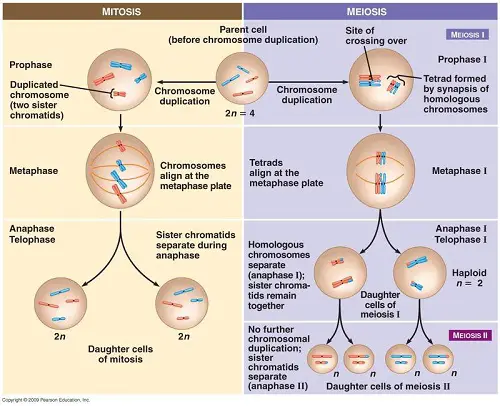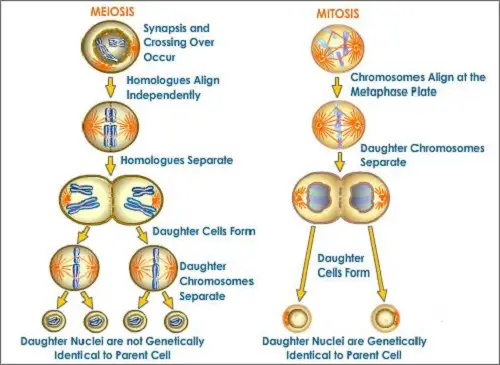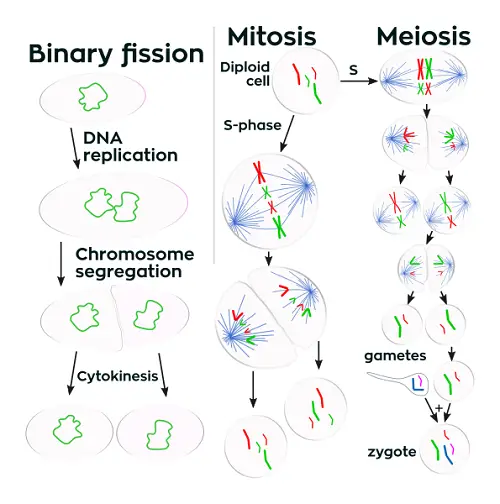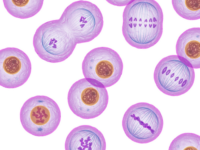What is Cell Division?
Cell division is the process by which a single cell divides into two daughter cells. It is an important component of the cell cycle. In prokaryotes, the cell division occurs through a process called binary fission in which the genetic material divides equally into two or more daughter cells. In eukaryotes, the cell division can be of two types, vegetative cell division or mitosis and reproductive cell division, also called meiosis [1]. The cells must undergo through interphase before going through either mitosis or meiosis. The interphase can be divided into G1, S and G2 phase, and this is followed by M phase, where M can be either mitosis or meiosis [2].

What is Mitosis?
Mitosis is a type of the cell division in which each parent cell divides into two genetically identical daughter cells. It is a part of the cell cycle in which the nucleus divides into two. Mitosis can be of divided into different stages like prophase, prometaphase, metaphase, anaphase and telophase [3]. It is usually preceded by S phase and succeeded by cytokinesis. In the mitotic phase, the genetic material that has been synthesized in the S phase, gets condensed and attach to spindle fibers that are pulled to the opposite sides of the cell. The cell then divides by cytokinesis and two new daughter cells are formed. Sometimes there is a defect in mitosis, this is called mitotic error. This results in the formation of more than two daughter cells. A defect in mitosis is very detrimental to the cell, can causes apoptosis and may lead to cancer [4].
What is Meiosis?
Meiosis is a type of cell division in which each parent cell is divided into four haploid (half the number of chromosomes) daughter cells. There are two meiotic divisions called Meiosis I and Meiosis II. The daughter cells from meiosis are genetically different from their parents. This occurs exclusively in eukaryotes and is a mechanism that maintains genetic diversity [5]. Meiosis helps in natural selection. In meiosis, first the chromosomes in the cells are duplicated leading to formation of identical sister chromatids. Then the DNA in the sister chromatids is exchanged by homologous recombination and crossovers. In the second meiotic division, there is no replication of DNA but the chromosomes segregate and the number to total chromosomes is halved in each daughter cell [6]. The errors in meiosis results in severe chromosomal defects like monosomy or trisomy. This leads to developmental disorders like Down syndrome, Turner syndrome, Patau syndrome, Triple X syndrome to name a few.
Similarities between Mitosis and Meiosis
There are several similarities between the two cell division processes, Mitosis and Meiosis. The major similarities are listed below
- Presence of similar stages like prophase, metaphase, anaphase and telophase is a major similarity between mitosis and meiosis. Both the cell division processes is preceded by interphase in which the cells grow and replicate their DNA. Then the cells enter prophase in which the condensation of DNA takes place. In the metaphase of both mitosis and meiosis, the chromosomes align in center of the cell. In anaphase, the chromosomes are pulled apart towards the opposite ends of the cell.
- Both mitosis and meiosis have the primary aim to divide the DNA of the parent cell into daughter cells. Both the processes condensation of the replicated DNA then to form chromosomes. The chromosomes are tightly packed DNA that can be pulled apart during segregation. The mechanism of the compaction of DNA and the proteins involved are similar in both mitosis and meiosis.
- The mechanism of segregation of chromosomes to the opposite ends to the cell is similar in mitosis and meiosis. The microtubules and spindle fibers play an important role in both the processes.
- Both mitosis and meiosis involve similar mechanism of dissolving and the reformation of nuclear membrane. Both of these processes, mitosis and meiosis occur in eukaryotes. Eukaryotes are characterized by the presence of membrane bound nucleus. The nucleus is bound by a membrane called nuclear membrane [7]. Prior to the segregation of chromosomes, the nuclear membrane is dissolved in both mitosis and meiosis. This allows for the chromosomes to align themselves at the middle of the cell and then pulled apart. After the chromosomes migrate to the opposite ends the nuclear membrane is formed again. This reformation of nuclear membrane is necessary for the viability of the daughter cells
- Although the fidelity of these two cell division process is very high, both mitosis and meiosis occasionally make errors. The errors of both these processes are detrimental to the cell. A number of diseases are caused by mitotic errors. Defects in meiosis cause developmental disorders like Down’s syndrome, Triple X syndrome and many more.
Summary
Both mitosis and meiosis are cell division processes that share several similarities with each other. They follow similar stages of progression and they both condense the previously replicated DNA. The mechanisms involved in chromosome segregation and reformation of nuclear membrane is similar in both the processes. Although both the processes have different functions, they share several fundamental similarities.
Author: Debashree Basu
Debashree received her PhD in Biochemistry and specialized in infectious diseases. She is a Research Scientist whose main focus is bacteria, yeast and mammalian cells. She published articles in peer reviewed journals.












Leave a Reply